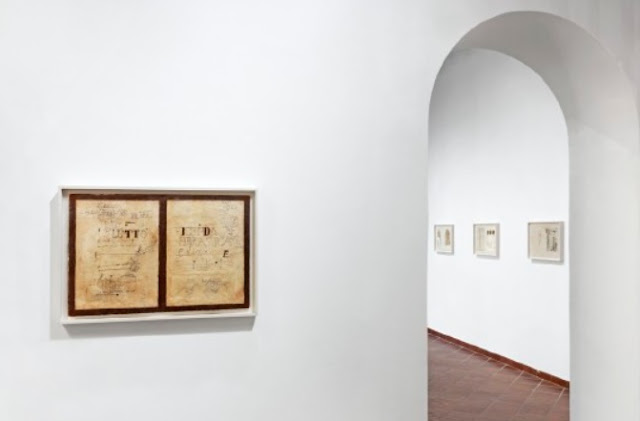La galleria White Cube nei suoi spazi di Londra ospita una mostra di Fred Tomaselli, fino al 13 Maggio.
CS
White Cube is pleased to present ‘Paper’, an exhibition of new and recent works by Fred Tomaselli. As its title suggests, the exhibition focuses on works on paper and includes photograms, collages and interventions onto the front page of The New York Times.
Tomaselli began working on ‘The Times’ series in 2005 during the Bush administration and has increasingly focused on this project in the ensuing years. Using large-scale digital facsimiles of the newspaper’s front page, these works highlight the tragedy, reality and absurdity of global politics through the addition of a combination of abstract, sardonic and cosmic imagery. Seeing his intervention into this ‘paper of record’, as just another subjective, editorial decision, among the many that go into the production of news, Tomaselli attempts to engage directly with both the images and accompanying text.
Titled simply with the date on which they were published, the works are the record of important events from the past few years, albeit distributed via a medium that, in the face of increasing digital information, is fast disappearing. Tomaselli has noted that these political, bucolic images are the ‘daily facts’ of his own life, offering a time line of his own experiences. Seeking to stop time and allow the works to resonate as their facts ‘vaporize into obsolescence’, landmark events are frozen and presented for closer scrutiny: the ‘perp-walk’ by bad actors, the warming of the planet or the actions of global leaders.
Both emotive and humorous, these pictorial subversions of familiar news images recall the dark humour of the German Expressionists, but more specifically the ‘Constellation’ drawings of Joan Miró begun in 1939 at the outset of WWII. In these drawings Miró arranged abstract shapes on paper like a constellation of stars, appearing to offer a serene, cosmic and infinite vision which transcended the horrors of the daily destruction of war. Similarly, Tomaselli says he is attempting to convey the ‘bipolar relationship between beauty and pain’ that defines current existence. In one work, for example, a Ukrainian woman mourning the tragedy of the Malaysian plane crash, carries a bouquet of flowers that obscures her face, the forms of which have been extended with real leaves, paint and photo-collage, into a stylised, all-over Mogul-like pattern spreading across the entire image. In another, a team of negotiators in the Iran nuclear deal burn out their eyes by staring into the sun, our solar system’s original nuclear furnace.
Tomaselli is a visual taxonomist who uses a process of collecting and cataloguing visual data – from newspapers, magazines or field guides to anatomical or botanical illustrations – as a way to interpret and understand the world. Produced alongside his paintings, the resulting collages exhibit a more direct and unmediated relationship with their source material, emerging out of what the artist calls ‘the rubble of utopian thinking’ − itself the legacy of a failed ‘60s transcendentalism combined with the volatile anger of punk. In this way, his delicate, complex and polymorphous images are able to deal with both an abundance of hedonistic beauty as well as ugly, political reality. In some places the hallucinatory, transformative nature of his imagery is overt, while in others it is more discreet. An infographic about global warming, for example, has been obfuscated by swirling amoeba-like patterns in orange, red and purple. While another image shows former billionaire investor Raj Rajaratnam, who was so scrutinised by the media during his insider trading scandal, reduced to simply an x-ray.
Like ‘The Times’ series of works, Tomaselli’s photograms and chemical portraits employ another dying, analogue media – that of chemical based photography. For the artist, paper is essentially the material that is being replaced by screens. First produced in the 1990s, Tomaselli’s chemical portraits attempt to get ‘into the inner and outer space of the sitter’: the process begins with the sitter answering a list of questions such as their date of birth and drug history. With this information Tomaselli creates images of constellations using the photogram process, depicting his sitter’s astrological sign and characteristics, reflecting the idea that in many cultures the exact time of birth determines the course of a person’s life. The artist adds, as collaged elements, any drugs that the sitter has used in order to suggest the modified reality that makes-up every individual experience. Exhibited with one image for each month of the year, the group of portraits alludes to a community of friends, while chronicling the passing of time.
Other photograms in the exhibition incorporate leaves grown in the artist’s own garden, harvested and then preserved. These flattened leaves are arranged onto photographic paper, which is then exposed to light and developed into photographs. The resulting images are painted over with colourful, hard-edged geometric patterns evoking floral still lifes, which ultimately remind us that nature and beauty persist despite the absurdity and horror of the world.


























































































